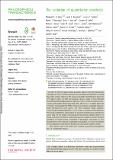Files in this item
The evolution of quantitative sensitivity
Item metadata
| dc.contributor.author | Bryer, Margaret A H | |
| dc.contributor.author | Koopman, Sarah E | |
| dc.contributor.author | Cantlon, Jessica F | |
| dc.contributor.author | Piantadosi, Steven T | |
| dc.contributor.author | MacLean, Evan L | |
| dc.contributor.author | Baker, Joseph M | |
| dc.contributor.author | Beran, Michael J | |
| dc.contributor.author | Jones, Sarah M | |
| dc.contributor.author | Jordan, Kerry E | |
| dc.contributor.author | Mahamane, Salif | |
| dc.contributor.author | Nieder, Andreas | |
| dc.contributor.author | Perdue, Bonnie M | |
| dc.contributor.author | Range, Friederike | |
| dc.contributor.author | Stevens, Jeffrey R | |
| dc.contributor.author | Tomonaga, Masaki | |
| dc.contributor.author | Ujfalussy, Dorottya J | |
| dc.contributor.author | Vonk, Jennifer | |
| dc.date.accessioned | 2022-01-11T10:30:17Z | |
| dc.date.available | 2022-01-11T10:30:17Z | |
| dc.date.issued | 2022-02-14 | |
| dc.identifier | 277340135 | |
| dc.identifier | 8e4a30e7-d8f0-4bc1-9082-815150d8656e | |
| dc.identifier | 34957840 | |
| dc.identifier | 000734386000001 | |
| dc.identifier | 85123036401 | |
| dc.identifier.citation | Bryer , M A H , Koopman , S E , Cantlon , J F , Piantadosi , S T , MacLean , E L , Baker , J M , Beran , M J , Jones , S M , Jordan , K E , Mahamane , S , Nieder , A , Perdue , B M , Range , F , Stevens , J R , Tomonaga , M , Ujfalussy , D J & Vonk , J 2022 , ' The evolution of quantitative sensitivity ' , Philosophical Transactions of the Royal Society B: Biological Sciences , vol. 377 , no. 1844 , 20200529 . https://doi.org/10.1098/rstb.2020.0529 | en |
| dc.identifier.issn | 0962-8436 | |
| dc.identifier.other | ORCID: /0000-0001-8116-9913/work/111210413 | |
| dc.identifier.uri | https://hdl.handle.net/10023/24639 | |
| dc.description | This work was supported by the National Science Foundation Graduate Research Fellowship Programme grant no. DGE-1419118 to S.E.K., and NSF 2000759 from the Division of Research on Learning in Formal and Informal Settings (DRL) to S.T.P., the Austrian Science Fund (FWF project no. P33928_B) to F.R., the Alfred P. Sloan Foundation Fellowship grant no. 220020300 to J.F.C., National Institutes of Health grant no. R01 HD085996 to J.F.C. and S.T.P. and the James S. McDonnell Foundation. | en |
| dc.description.abstract | The ability to represent approximate quantities appears to be phylogenetically widespread, but the selective pressures and proximate mechanisms favouring this ability remain unknown. We analysed quantity discrimination data from 672 subjects across 33 bird and mammal species, using a novel Bayesian model that combined phylogenetic regression with a model of number psychophysics and random effect components. This allowed us to combine data from 49 studies and calculate the Weber fraction (a measure of quantity representation precision) for each species. We then examined which cognitive, socioecological and biological factors were related to variance in Weber fraction. We found contributions of phylogeny to quantity discrimination performance across taxa. Of the neural, socioecological and general cognitive factors we tested, cortical neuron density and domain-general cognition were the strongest predictors of Weber fraction, controlling for phylogeny. Our study is a new demonstration of evolutionary constraints on cognition, as well as of a relation between species-specific neuron density and a particular cognitive ability. This article is part of the theme issue 'Systems neuroscience through the lens of evolutionary theory'. | |
| dc.format.extent | 12 | |
| dc.format.extent | 836086 | |
| dc.language.iso | eng | |
| dc.relation.ispartof | Philosophical Transactions of the Royal Society B: Biological Sciences | en |
| dc.subject | Weber fraction | en |
| dc.subject | Brain evolution | en |
| dc.subject | Quantity discrimination | en |
| dc.subject | BF Psychology | en |
| dc.subject | DAS | en |
| dc.subject.lcc | BF | en |
| dc.title | The evolution of quantitative sensitivity | en |
| dc.type | Journal article | en |
| dc.contributor.institution | University of St Andrews. School of Psychology and Neuroscience | en |
| dc.identifier.doi | 10.1098/rstb.2020.0529 | |
| dc.description.status | Peer reviewed | en |
This item appears in the following Collection(s)
Items in the St Andrews Research Repository are protected by copyright, with all rights reserved, unless otherwise indicated.

